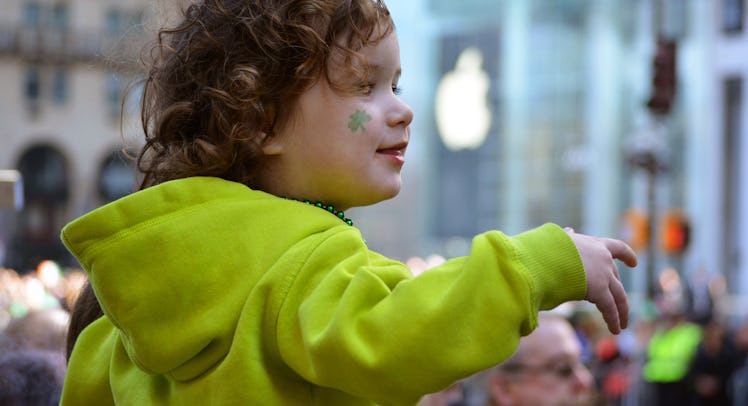What Does it Mean for an American Kid To Be ‘Irish’?
An Irish historian talks about the evolving Irish-American Identity from the Colonial Period to today.

There are 40 million Americans who identify as Irish-American. Which means there will be a lot of celebration when St. Patrick’s Day arrives, be it with green beer, Guinness, or their religious community. But the fact that the holiday is celebrated in so many different ways marks the culmination of a long evolution of what it means to be Irish and American.
That identity — cultural, ethnic, religious — has become increasingly nebulous. What it was to be Irish-American 40 years ago, or 100 years ago, is a far cry from what it means to be an Irish-American today. Luckily, there’s a recorded history of the evolution of the Irish-American identity and there are academics, like Professor Barry McCarron at the Irish House at NYU, who have spent their lives studying that history.
Here, McCarron talks about the evolving Irish-American identity and what it means for kids today.
Where — and when — did the roots of Irish-American identity begin to take hold?
When many Americans think of Irish America, they think of the Great Irish Famine in the 19th century when you have this large influx of Irish into the Americas and cities on the East coast. But Irish migration actually goes back to the Colonial Period. Up until mostly the 1820s or 1830s, Irish migration is mostly a Protestant story, who later become known as the Scots-Irish.
If you look at the recent U.S. census data today, there are roughly 35 million Americans who self-identify as an Irish or having Irish ancestry. But most of those identify themselves as Protestant.
So where did the Catholic Democrat thing come from?
During the Gorta Mor, which means great hunger, roughly one million Irish died and some 1.5 million left Ireland. After the famine, Irish identity was very much aligned with the Catholic Church and the Democratic Party.
The Protestant Irish who identified as Irish American take on this new identity as Scots-Irish to differentiate themselves from the impoverished Catholic-Irish coming to American cities, with large amounts of hostility and discrimination from the whole society.
Why did Irish identity become aligned with a certain political party?
It was largely conditioned by the circumstances in which the Catholic Irish found themselves in. The whole society was controlled and dominated by the White Anglo Saxon Protestants who were very hostile to the Catholic Irish and their religion.
The Irish, in many ways, were being pushed into associating with these institutions as a way to protect themselves against the whole society, which was hostile to their interests. The Irish were also involved in the American Labor Movement and largely dominated that as well, especially by the early 20th century.
Do many Irish still identify as Catholic and Democratic and pro-Labor now?
By the 1960s, you had someone like JFK reach the pinnacle of American political power. By then, the Irish had really made it. They were very successful and they had degrees and white collar jobs. For Irish-Americans from the 1960s up to today, their identity has been a choice for them.
Identity became a choice, as opposed to something that was forced upon the Irish-American community. So you begin to see divergent expressions of Irish identity.
What do you mean by having an identity as a choice? Or what does being able to choose that identity look like in practice?
St. Patrick’s day is coming up. Irish Americans have parades in many cities around the United States. Some of the organizing committees of these parades have been reluctant to allow groups such as LGBTQ+ community to be involved in the parade. There’s a lack of consensus as to what constitutes an Irish identity. It’s much more fluid and much more contested. So getting back to your earlier question — about what it means to be Irish today — you get a range of responses.
Some Irish-Americans talk about their family. Others talk about Irish culture. And very interestingly, as many as 85 percent of those Irish-Americans we surveyed have an interest in Irish studies, Irish culture, and sporting activities.
Most of those Irish Americans who claim Irish heritage or descent are protestants. Of the 40 million Irish Americans who claim descent, 20 million of those are Protestant and 13 are Catholic. That may come as a surprise to many Americans because the traditional assumption is that the Irish were Catholic.
So in other words, being an Irish-American kid today — and since the 1960s — means pretty much whatever you want it to mean.
I grew up in Ireland. I went to university there, and I came to the U.S. in 2008. Most of the Irish-Americans I meet, meaning those who were born and raised in the United States, they’re very much American first and then perhaps Irish second.
My definition of what constitutes Irishness will be very, very different from that of the second third or fourth or fifth generation of Irish Americans of today. We have a lot of common ground. A major component of Irish identity in my mind is the knowledge of Irish literature, history, and the language. I believe there are something like 20,000 speakers of the Irish language in the U.S. today. For me, that’s the essence of what it means to be Irish. Not so much the religious components, or even being born in Ireland. I just think the parameters of Irishness have been very much broadened in the last decade or two. Today, at least in my mind, we should consider those and Irish Americans who identify as Irish for whatever their reasons are as part of the Irish diaspora.
This article was originally published on